From the earliest days of Port Adelaide’s European settlement, a number of different ferries and ferry operators provided a direct link across the Port River from the ‘town’ to Lefevre Peninsula. Initially an informal service provided by watermen operating oar-driven craft or small sailing vessels, the ferry link between the Port and Birkenhead ultimately evolved into a regular means of transit plied by specially-built motorboats. Another link, known colloquially as ‘Dunnikier’s Ferry’, employed rowboats to transport people and goods between Mundy Street and Fletcher Road. Completion of Birkenhead Bridge in 1940 created a faster, more efficient means of crossing the river, and resulted in discontinuation of all existing ferry services.
Origins
The first ‘ferries’ to operate between Port Adelaide and Lefevre Peninsula comprised a ragtag assortment of small boat owners (known alternately as ‘watermen’ and ‘boatmen’) who charged a fee to transport people and goods across the Port River. These same individuals were also often contracted to move passengers and cargo between the Port and large vessels moored in the inner harbour. Most watermen likely operated from landing steps built at the end of Commercial Road, a point conveniently situated on a stretch of riverbank between the South Australian Company warehouse and original Customs House. However, the informal nature of the service meant that passengers could be picked up and deposited at just about any accessible point along the river’s course.
Excessive Fees
During the first decades of Port Adelaide’s existence few watermen were available to perform these much-needed services, and the lack of competition gave them free reign to charge exorbitant rates. In February 1848, a group of passengers left behind at McLaren Wharf by the Sydney-bound steamship Juno (which had departed two hours earlier than scheduled) were charged as much as £4 per head by ‘rapacious’ watermen who quickly arrived on the scene to ‘make the most of a pressing opportunity’ (South Australian Register, 2 February 1848). One family that was unable or unwilling to pay the fee was reportedly abandoned at the wharf and ultimately lost their berths and the cost(s) of their passage.
By 1854 the number of watermen officially operating within the Port had increased to twenty-five, but the rise in competition seems to have had little effect on their propensity for price-gouging. An April 1854 article in the South Australian Register announced that the Port’s watermen had banded together and agreed to commence charging one shilling per passenger for transit across the river to Lefevre Peninsula. In an effort to maintain the inflated price, each signatory to the ‘resolution’ pledged to accept a ‘fine’ of five shillings in the event they were caught ferrying passengers for less than the prescribed fare. Citizenry within the Port were understandably outraged, and expressed exasperation that watermen would command such a high price for ‘a journey of a hundred yards’ (91 metres). At least one person editorialised to the South Australian Register that a fixed-price public ferry be established by the colonial government in conjunction with a mandatory licensing system for all prospective watermen.
The Port Adelaide and Lefevre Peninsula Ferry Company
Despite growing public interest in a regulated ferry service across the Port River, it was not until the late 1870s that local government finally resolved to translate the idea into reality. Following a meeting of interested parties in January 1877, the Port Adelaide and Lefevre Peninsula Ferry Company was established and plans put in motion to construct landing stages and other shore-based infrastructure. On the Port Adelaide side of the river, more steps and a floating platform were added to the existing landing at the end of Commercial Road, while a purpose-built jetty measuring 200 feet (61 metres) in length was erected opposite Commercial Road on the Birkenhead shoreline. The South Australian Company initially complained that the ferry landing at Commercial Road would interfere with the use of McLaren Wharf (which the company owned and operated), but ultimately agreed to its construction after a compromise was reached with the ferry company, Port Adelaide City Council, and South Australia’s Marine Board.
Port Adelaide’s first steam ferry, appropriately named Unique, was ordered from the firm Messrs. McAllan, Smith & Co. in June 1877. The wooden-hulled vessel measured 42 feet (13 metres) in overall length, had a 10-foot (three-metre) beam amidships, and featured a double-ended design that allowed it to dock against the ferry landing with either its ‘bow’ or ‘stern’. The ferry’s unique hull arrangement was complimented by its propulsion system, which comprised a single, centrally-mounted propeller at either end capable of generating a cruising speed of five-and-a-half knots per hour (10 kilometres per hour). Both screws were powered by a single steam engine positioned on the ferry’s deck amidships. Unique’s passenger deck was bounded by a taffrail with a three-foot (0.9-metre) wide break at either end that allowed up to 80 individuals to walk on and off the vessel. Once aboard, passengers could either be seated or remain standing for the duration of the short trip across the Port River.
The ferry service officially commenced on 27 October 1877, and over 900 people used it on its first full day of operation. Another 4000 mobbed the ferry landing on Christmas Day 1877 and, following an additional crush of people on New Year’s Day 1878, a police officer was stationed near the steps during subsequent holidays in an effort to prevent overcrowding. Due to its low cost (one penny per one-way fare) and regular timetable, the ferry proved immensely popular and quickly turned a profit. However, its success was short-lived and by the end of 1878 began to show a small loss on operating costs. Consequent fare increases led to a gradual reduction in passengers, and by 1890 the ‘Central Ferry’ operated by the Port Adelaide and Lefevre Peninsula Ferry Company was forced out of business.
Subsequent Ferry Services
In the wake of the ferry company’s closure, ferry services continued to operate between Commercial Road and Birkenhead. Several were operated by private individuals or companies, and—due to costs associated with building, fuelling and maintaining engine-powered watercraft—resulted in the brief re-emergence of rowboats as the primary mode of transportation across the Port River. During this period a second service, known as the ‘Dunnikier Ferry’, used oar-driven punts and other vessels to transport passengers between Mundy Street in Port Adelaide and a landing at Dunnikier Slip on the Birkenhead side of the river. The majority of Dunnikier Ferry patrons were employees of the shipyards owned by Henry Fletcher and Samuel Jenkins, and preferred the service because it provided the most direct link between their homes and places of employment.
The Port Adelaide City Council assumed control of both the Dunnikier Ferry and Central Ferry routes in 1900, and in subsequent years successfully litigated to charge license fees to those wishing to operate independent ferry services. In 1904 the Council took possession of Victor, a purpose built ferry with a 30-passenger capacity, and employed it as Unique’s long-awaited replacement on the Central Ferry route. Victor was constructed of jarrah, deal (Scots pine) and kauri timber, and had overall length, breadth and depth dimensions of 28 feet (8.5 metres), eight feet (two metres) and four feet (one metre), respectively. It was powered by a two-cylinder Victor oil burning engine, and capable of generating eight horsepower. Like Unique, it was outfitted with one propeller at each end of the hull, but also modified with ‘guardirons’ that protected its screws against ferry landing steps and other underwater obstructions.
By 1910, Victor was regularly plagued by maintenance issues, and both local citizenry and government representatives were clamouring for a replacement. Success, a double-ended vessel measuring 38 feet (11.5 metres) in overall length and capable of accommodating 110 passengers, was nominated for the purpose but soon labelled ‘The Terrible Blunder’ because of its fuel inefficiency and high operating costs. At around the same time, the Port Adelaide City Council was targeted by the South Australian Company for installing a new floating pontoon adjacent to the ferry landing at Commercial Road. Arguing once again that the landing impeded movement of shipping at McLaren Wharf, the South Australian Company successfully sued the Council to have the pontoon removed. Expenses associated with the resulting legal proceedings had a significant impact on the Council’s coffers, and Success was laid up for several years as a result. In the interim, Victor was placed back in operation and served the Central Ferry route (in conjunction with a rowboat).
Success returned to service in August 1915. One year later, the Council elected to discontinue oversight and operation of the Central and Dunnikier ferry routes, and put them (and their associated vessels) up for tender. The response was underwhelming, and it was not until 1918 that two private individuals, John ‘Jack’ Murch and William ‘Mitty’ Johnson, signed a contract to assume operational control of the Central Ferry. One of their first tasks was to decommission Success and replace it with Venturance, a 45-foot (14-metre) long wooden-hulled vessel powered by a kerosene engine and capable of accommodating 100 passengers. Although laid up, Success caused one final spectacular headache for its owners. In the early morning hours of 15 May 1920, the boat exploded when Mitty Johnson inadvertently ignited fuel fumes that had accumulated in the engine compartment. Johnson was lucky to escape with relatively minor injuries, but the vessel suffered extensive damage and was never again used as a ferry.
Final Years: Lena M
The joint lease between Jack Murch and Mitty Johnson expired in 1922, and the ferry business was subsequently taken over by Murch and his sons Reginald and Lochie. Over the course of ten weeks, the three men built a new wooden-hulled ferry and named it Lena M after Jack Murch’s youngest daughter. Featuring the now standard double-ended hull design and powered by a kerosene engine, Lena M entered service in 1923 and was the last ferry to operate in Port Adelaide. The vessel originally accommodated 120 passengers, but this number gradually reduced to 60 as time and an active work schedule took a toll on its architecture. Adult passengers were charged one penny for a one-way fare, and the cost to children was a halfpenny. Lena M was an icon of the inner harbour, and a rite-of-passage among children living in the Port was their inaugural ride across the river on its worn wooden decks. Although sturdily built, Lena M was notoriously slow, and another ‘initiation’ commonly undertaken by the Port’s teenaged boys was to attempt to swim the width of the river faster than the ferry as it crabbed its way across against adverse winds and tides.
During its first few years in operation, Lena M averaged 650 fares per month, but this number diminished significantly in the wake of the Waterside Workers’ Strike and Great Depression. The establishment of a bus service across the Jervois Bridge put additional pressure on the ferry, and by the mid-1930s less than 70 tickets were sold monthly. Jack Murch threatened to discontinue the service in 1931, but changed his mind after the Port Adelaide City Council offered to partially subsidise it. Lena M soldiered on for another nine years, but its fate was already sealed. As the decade progressed, changes to the Port’s land-based transport infrastructure drew increasingly greater numbers of potential customers away from the ferry. Lena M’s final voyage—the last ferry service across the Port River—occurred on 14 December 1940, and coincided with the opening of the Birkenhead Bridge.


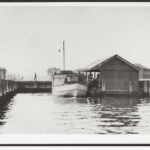

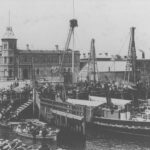
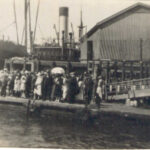
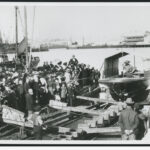
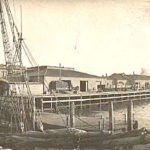
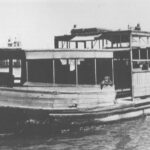
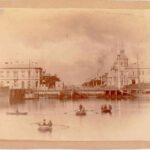
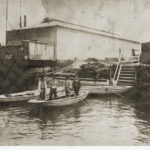

Comments
2 responses to “Port Adelaide Ferries”
Please let me know where I can obtain a high resolution copy of the photo samm_image_7176_mod which appears at the head of this web page https://sahistoryhub.history.sa.gov.au/subjects/port-adelaide-ferries
Similarly, please let me know where there might be close up photos of Port River riow-boat ferry men of the same era as those shown in the image I have referenced.
Hi John,
The photo credits can be found under the Media tab at the top of this page. That image is Watermen ferrying passengers across the Port River, 1889. The Commercial Road ferry landing is visible in the background
South Australian Maritime Museum Photographic Collection, 7176
You can contact the Maritime Museum at https://maritime.history.sa.gov.au/contact/